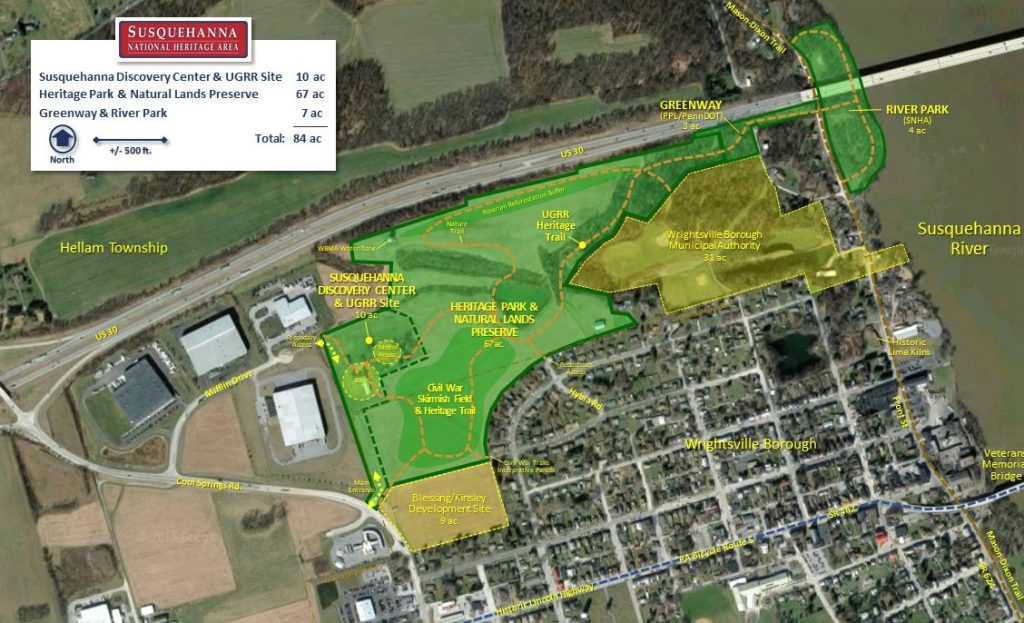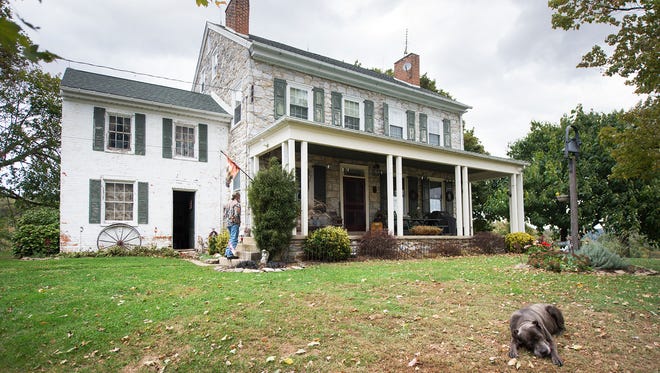Mifflin House, an Underground Railroad site, could become part of visitor attraction in Pa.
April 8, 2021
Efforts to save the historic Mifflin House, a stop on the Underground Railroad, have grown into a bigger vision to attract visitors to the region.
It could become part of a regional visitor center that shares the local history and how it ties into the American story, said Mark Platts, president of the Susquehanna National Heritage Area.
Under a concept proposed by the organization, the 18th-century farmhouse in eastern York County, just off Route 30, would be restored for the public to learn about its key role on the Underground Railroad. The Mifflin family helped hide enslaved African Americans, who had escaped, and ferry them across the river on their way to Philadelphia.
The barns would become a Susquehanna Discovery Center, a regional welcome and interpretive site that would include exhibit galleries and offices for Platts’ organization. Outside, visitors could see where a Civil War skirmish happened just before the burning of the bridge at Wrightsville.

Preservationists have been working for years to save the Mifflin House, which sits in a growing business park in Hellam Township. In 2019, they reached an agreement with Kinsley Properties, giving organizations two years to raise funds to preserve the farmhouse, the barn and 62 acres.
The deadline has passed, but preservationists recently made an offer to buy the property, said Mindy Crawford, executive director of Preservation Pennsylvania.
“We’re still in negotiation, but we’re feeling really positive,” she said.
The Conservation Fund would likely purchase the property, and the Susquehanna National Heritage Area would own it, she said. A similar process was used to preserve the site of Camp Security, a Revolutionary War prison camp in neighboring Springettsbury Township.
The Mifflin House and the land it sits on are owned by Wayne and Susan Blessing and Robert and Agnes Blessing. Kinsley Properties has been developing the land for the family.

How the concept evolved
While preservationists voiced opposition to the proposed demolition of the historic house during the land development process, Crawford tried to talk with the developer and the owners about possibly developing a preservation plan.
Eventually, Preservation Pennsylvania began discussing the property with the Conservation Fund and the Susquehanna National Heritage Area. Both had been involved in the effort to save Camp Security.
The organizations decided to work together. During the meetings, Platts came up with an idea to protect the property and do an interpretation on the house with its Underground Railroad connection, Crawford said.
At that time, it was not for the heritage area’s use, she explained. It wasn’t until later that the heritage area board saw this property as a potential new gateway for the group’s national designation.
The organizations met with Tim Kinsley, president and CEO of Kinsley Properties, and his attorney to discuss the possibilities. An appraisal was done, and they tried to find sources for funding it.
Preservation Pennsylvania vowed to keep working on it until it is — or isn’t — successful.
Funding started to fall into place, and an official offer on the property was made a few weeks ago, Crawford said. It would involve more acreage than originally proposed.
The concept is a great use for the property, she said. It would preserve the house as well as the open space.
“Discussions with the preservationists about the Mifflin House are ongoing, but no final agreement has been reached,” Kinsley Properties said in a statement.
Grant, other funding to help with project
The concept plan lists acquisition and related costs at $4,250,000. It proposes saving more land — 77 acres — but would leave some property for development close to Wrightsville borough, Platts said.
The overall project, including design and construction, is estimated to cost $13.4 million. It could take five to eight years, after acquisition, for full development.
Some money has been raised, including a $1.5 million Pennsylvania Redevelopment Assistance Capital Program grant, Platts said.
So far, the organization has raised more than $3 million.
Randolph Harris, a consulting historian in Lancaster County, said the concept, if it falls into place, would make a perfect attraction.
It would help visitors understand the connection between the burning of the bridge in Wrightsville to the Battle of Gettysburg.
It also would allow visitors to trace the steps that freedom seekers took on the Underground Railroad as they left York County and crossed the Susquehanna River into Lancaster County.
Columbia Borough plans to expand its park north of the Route 426 bridge, where the old bridge piers and remnants of the Pennsylvania Canal exist. The bridge and boats helped the freedom seekers to escape.
Harris, who gives private Underground Railroad tours, said he starts near the Mifflin House and moves east. Participants are enthralled to hear how it came together in the Susquehanna River area.
Preservation Pennsylvania listed the Mifflin House as one of the state’s most endangered historic resources in 2017. It is considered to be historically significant enough to be eligible for being included on the National Register of Historic Places, the Pennsylvania State Historic Preservation Office has determined.
It’s not unusual for a project to take several years to come together, Crawford said. It takes a property about seven years to go from at-risk to saved.
The Susquehanna National Heritage Area serves York and Lancaster counties, and its offices currently are located at the Zimmerman Center for Heritage in Lower Windsor Township.
Both the Zimmerman Center and the Columbia Crossing River Trails Center, which is on the Lancaster County side, would remain in use if the Susquehanna Discovery Center comes to fruition, Platts said. The organization offers free river discovery tours from the Zimmerman Center.

